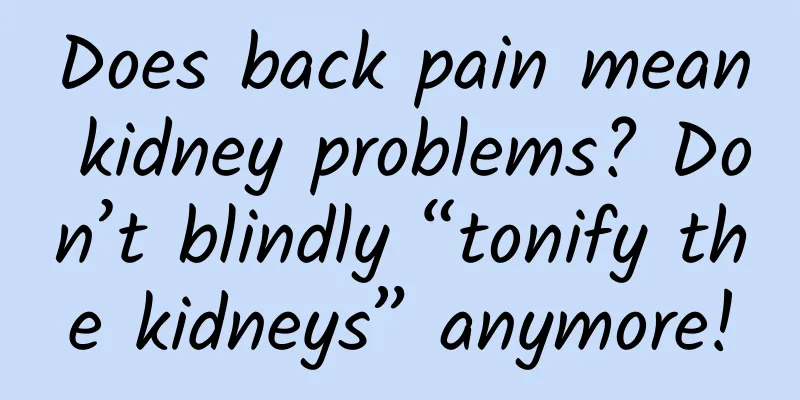Does back pain mean kidney problems? Don’t blindly “tonify the kidneys” anymore!

|
Author: Chen Zhou Shanghai Changhai Hospital Cartoon: Chen Zhou Shanghai Changhai Hospital Reviewer: Guo Zhiyong, Chief Physician, Shanghai Changhai Hospital Have you ever experienced back pain in your life? When you cry out about back pain or soothe your lower back with one hand, do people around you laugh at you and say, "Is it kidney deficiency? You should pay attention to kidney tonification!" So, does "back pain" really mean that there is something wrong with our kidneys? Scientific understanding of low back pain Low back pain is really too common in real life. More than 80% of adults have experienced low back pain, and some people even suffer from it for their entire lives. Although there are many diseases and complications related to low back pain, fortunately, in most cases, the initial low back pain is usually self-limiting, which means that even without treatment, it can be relieved after 4 to 6 weeks. Of course, individual exceptions still need to be taken seriously. Are you a high-risk group for low back pain? People who do heavy manual labor, sedentary office workers, doctors and other high-stress groups, people with anxiety or depression, women, the elderly, smokers and obese people are all at high risk of low back pain. If you are one of these high-risk groups or are experiencing low back pain, it is strongly recommended that you continue reading. Why do people have lower back pain? Before answering this question, we need to first understand the anatomy of the waist and back. The "waist" we often talk about generally refers to the area below the back and above the buttocks, which is the area corresponding to the lumbar spine. From the outside to the inside of the waist, there are skin, subcutaneous tissue, waist muscles, spine, spinal nerves, kidneys, adrenal glands and other organs. Going deeper and "walking" further inwards, you will reach the abdomen. Figure 1 Copyright image, no permission to reprint From an anatomical point of view, it is not difficult to understand that when any organ or tissue belonging to the waist from the inside to the outside has a problem, it may cause back pain. For example, improper exercise leads to strain of waist muscles, or damage and bulging of spinal discs can cause back pain. In this way, back pain is not only caused by kidney problems. Therefore, the statement mentioned in the previous article that "once back pain occurs, it is 'kidney deficiency'" is one-sided, and "tonifying the kidney" cannot solve the problem. What causes low back pain in life? There are too many reasons for low back pain. Many times, even after many tests, the cause may not be found. Low back pain in daily life is often caused by lumbar muscle strain/muscle strain, lumbar disc herniation, osteoporosis, ankylosing spondylitis and other diseases; renal low back pain is mainly common in kidney stones and acute pyelonephritis. Low back pain caused by tumors in other organs such as kidneys is relatively rare. Below is a brief description of the characteristics of different diseases that cause low back pain and the medical departments that should be consulted. • Muscle strain: Low back pain usually occurs when the muscles are overstretched, which often occurs during strenuous exercise or traffic accidents. You should see an orthopedic or rehabilitation doctor. • Lumbar muscle strain: generally refers to chronic inflammatory damage to soft tissues such as lumbar muscles. Lumbar pain is often persistent. You should see an orthopedic or pain specialist. • Lumbar disc herniation: usually long-term and recurrent low back pain, which may be accompanied by pain or numbness in the lower limbs. You should consult an orthopedic or pain department. • Osteoporosis: It is common in postmenopausal women and the elderly, usually with chronic mild pain. You should see an orthopedic specialist. • Urinary system stones: Most patients have a history of kidney stones. If a kidney stone falls and gets stuck in the ureter, unbearable renal colic will occur. You should go to the emergency department or urology department as soon as possible. •Acute pyelonephritis: It is common in women and is often accompanied by fever or nausea, or frequent urination, urgency, and pain. You should see a nephrologist immediately. What are the treatments for low back pain? To treat low back pain, you must first find the cause and then treat it symptomatically. Usually, surgery is rarely needed to treat low back pain. If there is no serious physical illness, you can try the following methods to relieve it. • Maintain proper exercise : rest as needed and move as much as possible, because active activities are beneficial to relieve low back pain, such as swimming, Tai Chi, yoga, etc. •Hot compress : It may help relieve back pain, but the temperature should not be too high to avoid burns. •Analgesics : Commonly used drugs are non-steroidal anti-inflammatory drugs, such as ibuprofen, acetaminophen, etc. • Tui Na or massage : usually performed by a professional physiotherapist or rehabilitation therapist. •Mindfulness-based stress reduction : For people with anxiety or depression, try practicing relaxation and meditation. |
<<: Millennial Moms’ View on Mobile Phones – Infographic
>>: Understanding Edema in One Article
Recommend
How to measure chest circumference
When female friends go to buy underwear, they mus...
Where should the moxibustion part be used for uterine cold?
The disease of cold uterus does not only cause dy...
What can women eat during confinement?
After giving birth to a baby for ten months, moth...
Can I eat Achyranthes bidentata during menstruation?
Maybe everyone in western Liaoning is not very fa...
Can a twin uterus give birth to a child?
Under normal circumstances, women only have one u...
Characteristics of early artificial abortion
When it comes to abortion, many people are famili...
A woman dreams of giving money to others
Girls are animals with very complex emotions. The...
How much bleeding did you get during early pregnancy?
A few drops of bleeding in the early stages of pr...
Is big breasts good?
Although today’s female friends all want their br...
What are the effects of computer radiation during early pregnancy?
The physical health of pregnant women is what the...
What is the growth process of a snail? Basic characteristics of a snail
Snails have a very wide range of food foraging, a...
How many days should I take medicine for medical abortion?
Medical abortion is a method of abortion chosen b...
Can pelvic inflammatory disease cause anal swelling?
Women's bodies are very sensitive and are eas...
My belly gets bigger before my period
Before menstruation, the lower abdomen appears bl...









